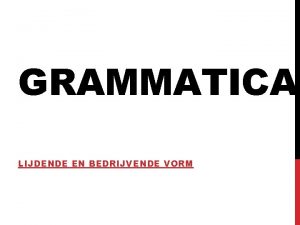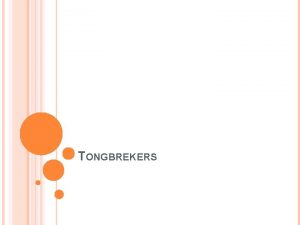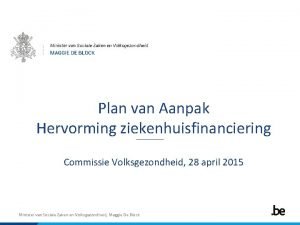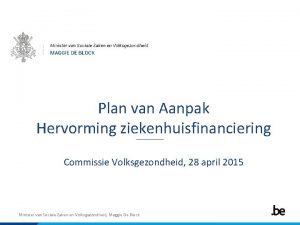Ziekenhuisfinanciering 2 0 Een visie van een gezondheidseconoom

































- Slides: 33

Ziekenhuisfinanciering 2. 0. Een visie van een gezondheidseconoom Lieven Annemans Universiteit Gent, VUB November 2013

Inhoud I. III. IV. Wat is het probleem? Hervorming van de gezondheidszorg Hervorming van de ziekenhuisfinanciering Finale bedenkingen 2

I. Wat is het probleem? 1. Health expenditure has been growing faster than the economy 2. Too much unnecessary care and large variability in care (incl. undertreatment) 3. Lack of coordination: 1 st line – 2 nd line; preventioncure; . . . 4. Increasing problems with equal access to care source: OECD 2009 3

Probleem! de gezondheidssector groeit(de) sneller dan de economie OECD Health Policy Studies. Value for Money in Health Spending, 2010, 204 pp 4

Overal nadruk op besparingen Jaarlijkse groeicijfers vd gezondheidssector in diverse landen OESO statistieken 2013 5

Maar impact van de vergrijzing & nieuwe technologie Vergrijzing +technologieën Enkel vergrijzing Itinera, 2010, Planbureau 2012 6

“Health is a value in itself. It is also a precondition for economic prosperity. People’s health influences economic outcomes in terms of productivity, labour supply, human capital and public spending. ”

I. Wat is het probleem? 1. Health expenditure has been growing faster than the economy 2. Too much unnecessary care and large variability in care (incl. undertreatment) 3. Lack of coordination: 1 st line – 2 nd line; preventioncure; . . . 4. Increasing problems with equal access to care source: OECD 2009 8

Recent study in Belgian hospitals • 34 hospitals (IMS database) • MCD and Financial information for all stays • 2 substudies: – Readmissions for same reason as index stay within 1 -3 months – Hospital acquired infections 9

Results re-admissions • 2. 1% readmissions (n = 27, 000) within 3 months after original hospitalisation • total cost to the health insurance = € 280 Mln • Wide variability between hospitals (1. 17 - 6. 40%) Results HAI • 5. 9% of the hospital stays associated with a HAI (+/75, 000 cases of HAIs). • Total cost of HAI in Belgium is estimated at € 533 Mln • Variability between hospitals (3. 77 -9. 78%). 10

Bizarre financiering 40% Budget financiële middelen Werkingskosten Verblijfskosten Verpleegkundigen Verzorgenden … 40% Afhoudingen op inkomsten van de artsen Op basis van betaling per prestatie 15% 5% Pharma Op basis van afgedwongen kortingen 11

Inhoud I. III. IV. Wat is het probleem Hervorming van de gezondheidszorg Hervorming van de ziekenhuisfinanciering Finale bedenkingen 12

5 solutions for a performant health care system 1. 2. 3. 4. 5. Setting goals and targets Revising structures and processes Search for cost-effectiveness in all what we do Invest in a perfect ICT system Revising the way healthcare providers are paid 13

1. The primary goal of health care policies • to maximize the health of the population within the limits of the available resources, and within an ethical framework built on equity and solidarity principles. Report of the Belgian EU Presidency, endorsed by the EU Council of Ministers of Health in Dec 2010 Must be translated in concrete SMART objectives 14

2. Change the structures & processes • A mandatory GP (medical coach) for everyone • Integrated care networks and case managers for multimorbidity (supervised by the medical coach) • “Goal oriented care” • More telemedicine and –prevention • Patient responsibility & self-monitoring • New professions (physician assistants, practice nurses, nurse-specialists) • … 15

16

The benefits of primary care oriented health systems • • Less hospital admissions Less emergency visits* Less non-evidence based surgery Less readmissions Better self reported health More prevention …. Een vaste huisarts voor IEDEREEN 17

3. Kosten-effectiviteit Kost LY A /Q Niet C-Eff - +/ ( old h s re Th NIEUW Huidige aanpak 00 0. 40 C-Eff NIEUW Dominant Gezondheidseffect (QALYs) 18 Annemans L. Health economics for non-economists. Academia. Press, 2008

4. Perfect health information system “ If you do not have all information for all the patients , all the time you are wasting your money ” George Halvorson, CEO, Kaiser Permanente intreview http: //vimeo. com/4039344 19

Improving quality and reducing costs - Is it possible ? Latest news from Kaiser Permanente • Cut Serious heart attacks by 62% in 10 years • Cut Heart attacks by 24 % in 10 years • Cut fractures in osteoporotic patients by 37% • Cut hospitalization in patients with co-morbidity by 70 %!!! 25% lower medical costs 10 % lower insurance primes Investing in IT: € 30 per member/year 20

5. Change the way we pay “Fee for Service” • Overconsumption (supplier induced demand) Prospective payments (Pay per stay) “ALL-IN” • Cost shifting • Risk selection • Quality • Unbundling • Outliers problems • … 21

Introduction of fee-for-service for socially insured consumers led to a higher increase in physician-initiated utilisation. This was most apparent in persons aged 25 to 54. Differences in the trend in physicianinitiated utilisation point to an effect of supplier-induced demand. Differences in patient-initiated utilisation (due to reduced cost sharing) indicate limited evidence for moral hazard. 22

More “Capitation”? • Fixed amount per patient per time period + + - decreased risk for overconsumption improved access more focus on prevention patient empowerment undertreatment? attractivity of young healthy patients? cost shifts? Not shown by KCE (KCE rapport , 2009) 23

Inhoud I. III. IV. Wat is het probleem Hervorming van de gezondheidszorg Hervorming van de ziekenhuisfinanciering Finale bedenkingen 24

Towards pay for quality? “From Paying to do things To Paying to do things right And Paying to do the right things” 25

Evidence on effects Targets with above 5% positive effect title 26

27

Cfr. Quality indicators Flanders http: //www. zorg-engezondheid. be/Beleid/Kwaliteit/Basisset 2012/#indicatoren • Moeder en kind • Oncologie • Orthopedie • Cardiologie • Ziekenhuisbreed domein 28

BUT: some pitfalls of P 4 Q 1. Poor definition of quality: structure, process and outcomes indicators 2. Not involving the physicians, lack of communication 3. Size and type of the financial reward/penalty not well studied 4. Problem with engaging physicians continuously 5. Patient case-mix 29

Opties voor ziekenhuisfinanciering Forfait per APRDRG per verblijf incl. 1 maand post P 4 Q Idem maar excl. artsen forfait voor intellectuele prestatie artsen P 4 Q Idem maar excl. artsen FFS voor intellectuele prestatie artsen P 4 Q ! Geen afhoudingen meer 30

IV. Final thoughts • Economisch denken in de zorg moet ten dienste staan en niet ten koste gaan van kwaliteit. • Eeen systeem met perverse financiële prikkels kan nooit performant zijn • Er is nog veel ruimte voor verbetering inzake kosteneffectiviteit • In de toekomst zal fee for service geleidelijk aan plaatsmaken voor “capitation” en P 4 Q • De toekomstige ziekenhuissector zal relatief kleiner en financieel gezonder moeten zijn • Een visie 2025 is nodig voor de ganse gezondheidssector. 31

Vanaf midden Februari 2014 32

Ziekenhuisfinanciering 2. 0. Een visie van een gezondheidseconoom Lieven Annemans Universiteit Gent, VUB November 2013
 Wat is een visie en missie
Wat is een visie en missie Kop van een stamper in bloemkelk
Kop van een stamper in bloemkelk Tekstverklaring
Tekstverklaring Kubus uitvouwen
Kubus uitvouwen Digitale meetinstrumenten
Digitale meetinstrumenten Wat is bedrijvende vorm
Wat is bedrijvende vorm Secundaire diktegroei
Secundaire diktegroei Darmcel
Darmcel Visie versus missie
Visie versus missie Visie / missie pyramide
Visie / missie pyramide Kenmerken zorgrelatie
Kenmerken zorgrelatie Mijn visie op onderwijs
Mijn visie op onderwijs Kees boeke
Kees boeke Medewerkersportaal icare
Medewerkersportaal icare Abn amro missie visie
Abn amro missie visie Ipsatief definitie
Ipsatief definitie Crm voorbeelden
Crm voorbeelden Verschil missie en visie
Verschil missie en visie Missie versus visie
Missie versus visie Voorbeeld draaiboek voor evenement
Voorbeeld draaiboek voor evenement Wat is een bladwijzer in een atlas
Wat is een bladwijzer in een atlas Tongbreker
Tongbreker Is een balans een momentopname
Is een balans een momentopname Een eigen huis een plek onder de zon
Een eigen huis een plek onder de zon Hoe lang eendenei uitbroeden
Hoe lang eendenei uitbroeden Een leven zonder dromen is als een tuin zonder bloemen
Een leven zonder dromen is als een tuin zonder bloemen Spierfibrillen
Spierfibrillen Lied 1010 tekst
Lied 1010 tekst Vier kenmerken van een maatschappelijk probleem
Vier kenmerken van een maatschappelijk probleem Ontwikkelingsland kenmerken
Ontwikkelingsland kenmerken Kenmerken toendraklimaat
Kenmerken toendraklimaat Norm van een vector
Norm van een vector Zijnerf van een blad
Zijnerf van een blad Alinea opbouw
Alinea opbouw
























































